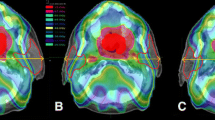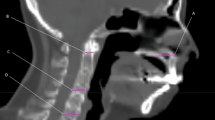Abstract
Purpose
This study aimed to assess, in a department of radiation oncology not equipped with in-room imaging systems, volumetric and positional changes of planning target volumes (PTVs) and organs at risk in head and neck (H&N) cancer patients treated with intensity-modulated radiation therapy (IMRT), using consecutive off-board computed tomography (CT) imaging. Dosimetric aspects were not investigated.
Materials and methods
Ten patients with H&N cancer underwent CT re-scanning at 3, 5, and 7 weeks. Positional changes of the PTVs and parotid glands as distances relative to the virtual isocentre were determined. The parotids glands (PGs) were re-delineated on each CT set and volume differences were computed. Anterior-posterior (AP) and latero-lateral (LL) displacements for the spinal cord at C1 and C6 level were calculated. Changes in patient body contours were evaluated by comparing the volumes within the external skin outline.
Results
Apart from two patients requiring re-planning due to substantial weight loss, our results evidenced no significant shifts of PTVs and PGs. PG volume decreased with a trend in volume reduction for the ipsilateral parotid. No significant shift of spinal cord at C1 and C6 level was detected, in either the AP or LL direction. The collected data demonstrated a trend in external skin contour volume loss.
Conclusions
Our preliminary results reflect the literature data and indicate that an off-line adaptive RT approach is appropriate in clinical practice.





Similar content being viewed by others
References
Barker JL, Garden AS, Ang KK et al (2004) Quantification of volumetric and geometric changes occurring during fractionated radiotherapy for head and neck cancer using an integrated CT/linear accelerator system. Int J Radiat Oncol Biol Phys 59:960–970
Schwartz DL, Garden AS, Thomas J et al (2012) Adaptive radiotherapy for head-and-neck cancer: initial clinical outcomes from a prospective trial. Int J Radiat Oncol Biol Phys 83:986–993
O’Daniel JC, Garden AS, Schwartz D et al (2007) Parotid gland dose in intensity-modulated radiotherapy for head and neck cancer: is what you plan what you get? Int J Radiat Oncol Biol Phys 69:1290–1296
Eisbruch A, Gregoire V (2009) Balancing risk and reward in target delineation for higly conformal radiotherapy in head and neck cancer. Semin Radiat Oncol 19:43–52
Eisbruch A, Foote RL, O’Sullivan B et al (2002) Intensity-modulated radiation therapy for head and neck cancer: emphasis on the selection and delineation of the targets. Semin Radiat Oncol 12:238–249
Saw CB, Chen H, Beatty RE, Wagner H Jr (2008) Multimodality image fusion and planning and dose delivery for radiation therapy. Med Dosim 33:149–155
Loo H, Fairfoul J, Chakrabarti A et al (2011) Tumor shrinkage and contour change during radiotherapy increase the dose to organ at risk but not the target volumes for head and neck cancer patients treated on the tomotherapy HiArt™ system. Clin Oncol 23:40–47
Zhang L, Garden AS, Lo J et al (2006) Multiple regions-of-interest analysis of setup uncertainties for head-and-neck cancer radiotherapy. Int J Radiat Oncol Biol Phys 64:1559–1569
Hong TS, Tomé WA, Chappell RJ (2005) The impact of daily setup variations on head-and-neck intensity-modulated radiation therapy. Int J Radiat Oncol Biol Phys 61:779–788
Wu Q, Chi Y, Chen PY et al (2009) Adaptive replanning strategies accounting for shrinkage in head and neck IMRT. Int J Radiat Oncol Biol Phys 75:924–932
Castadot P, Geets X, Lee JA et al (2010) Assessment by a deformable registration method of the volumetric and positional changes of target volumes and organs at risk in pharyngo-laryngeal tumors treated with concomitant chemo-radiation. Radiother Oncol 95:209–217
Bhide SA, Davies M, Burke K et al (2010) Weekly volume and dosimetric changes during chemoradiotherapy with intensity-modulated radiation therapy for head and neck cancer: a prospective observational study. Int J Radiat Oncol Biol Phys 76:1360–1368
Ahn PH, Chen CC, Ahn AI et al (2011) Adaptive planning in intensity-modulated radiation therapy for head and neck cancers: single-institution experience and clinical implications. Int J Radiat Oncol Biol Phys 80:677–685
Ricchetti F, Wu B, McNutt T et al (2011) Volumetric change of selected organs at risk during IMRT for oropharyngeal cancer. Int J Radiat Oncol Biol Phys 80:161–168
Capelle L, Mackenzie M, Field C et al (2012) Adaptive radiotherapy using Helical Tomotherapy for head and neck cancer in definitive and post-operative settings: initial results. Clin Oncol 24:208–215
Zhao L, Wan Q, Zhou Y et al (2010) The role of replanning in fractionated intensity modulated radiotherapy for nasopharyngeal carcinoma. Radiother Oncol 98:23–27
Schwartz DL (2012) Current progress in adaptive radiation therapy for head and neck cancer. Curr Oncol Rep 14:139–147
Castadot P, Lee JA, Geets X, Gregoire V (2010) Adaptive radiotherapy of head and neck cancer. Semin Radiat Oncol 20:84–93
Conflict of interest
A. Reali, S.M. Anglesio, G. Mortellaro, S. Allis, S. Bartoncini and M.G. Ruo Redda declare no conflict of interest.
Author information
Authors and Affiliations
Corresponding author
Rights and permissions
About this article
Cite this article
Reali, A., Anglesio, S.M., Mortellaro, G. et al. Volumetric and positional changes of planning target volumes and organs at risk using computed tomography imaging during intensity-modulated radiation therapy for head–neck cancer: an “old” adaptive radiation therapy approach. Radiol med 119, 714–720 (2014). https://doi.org/10.1007/s11547-014-0386-z
Received:
Accepted:
Published:
Issue Date:
DOI: https://doi.org/10.1007/s11547-014-0386-z




